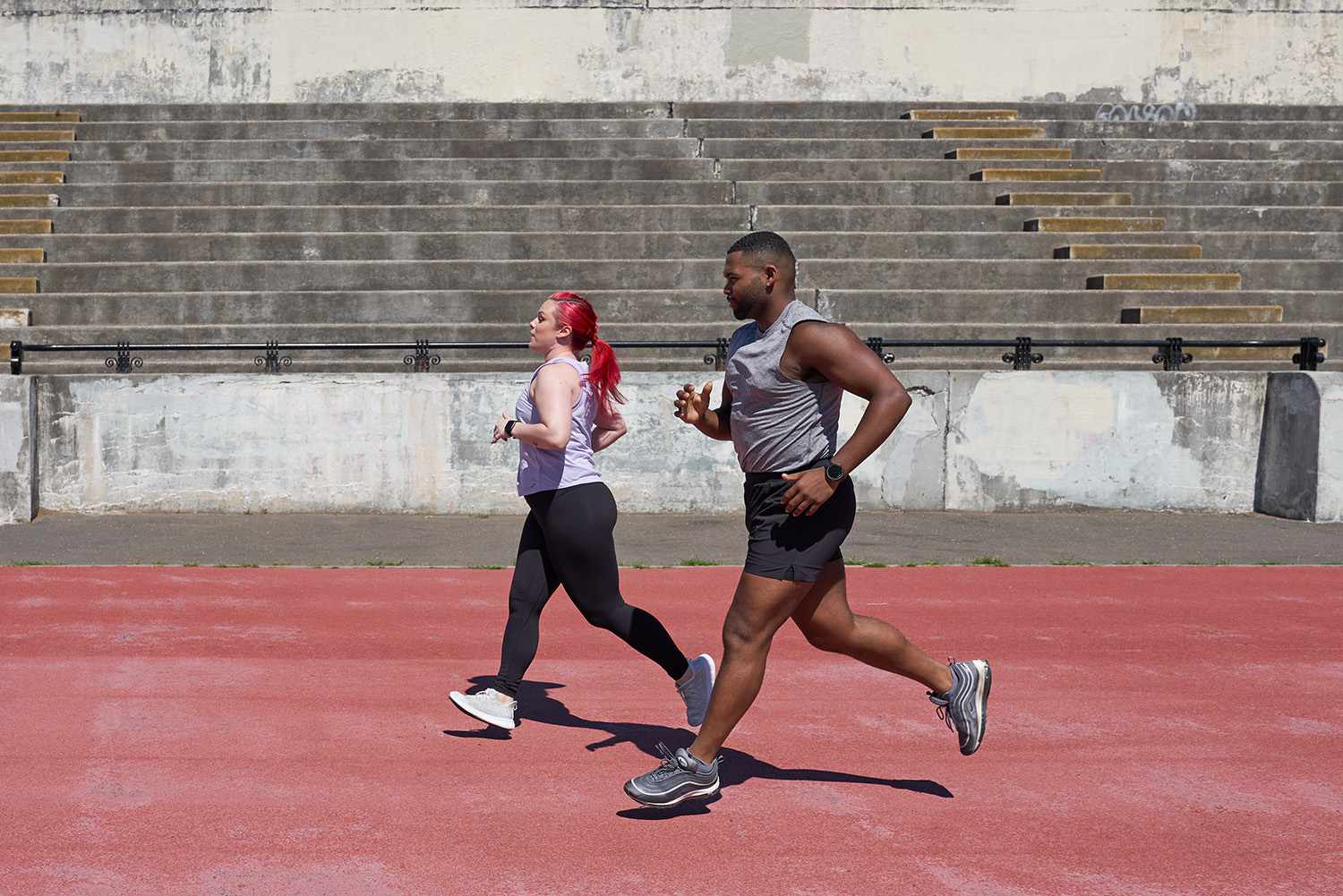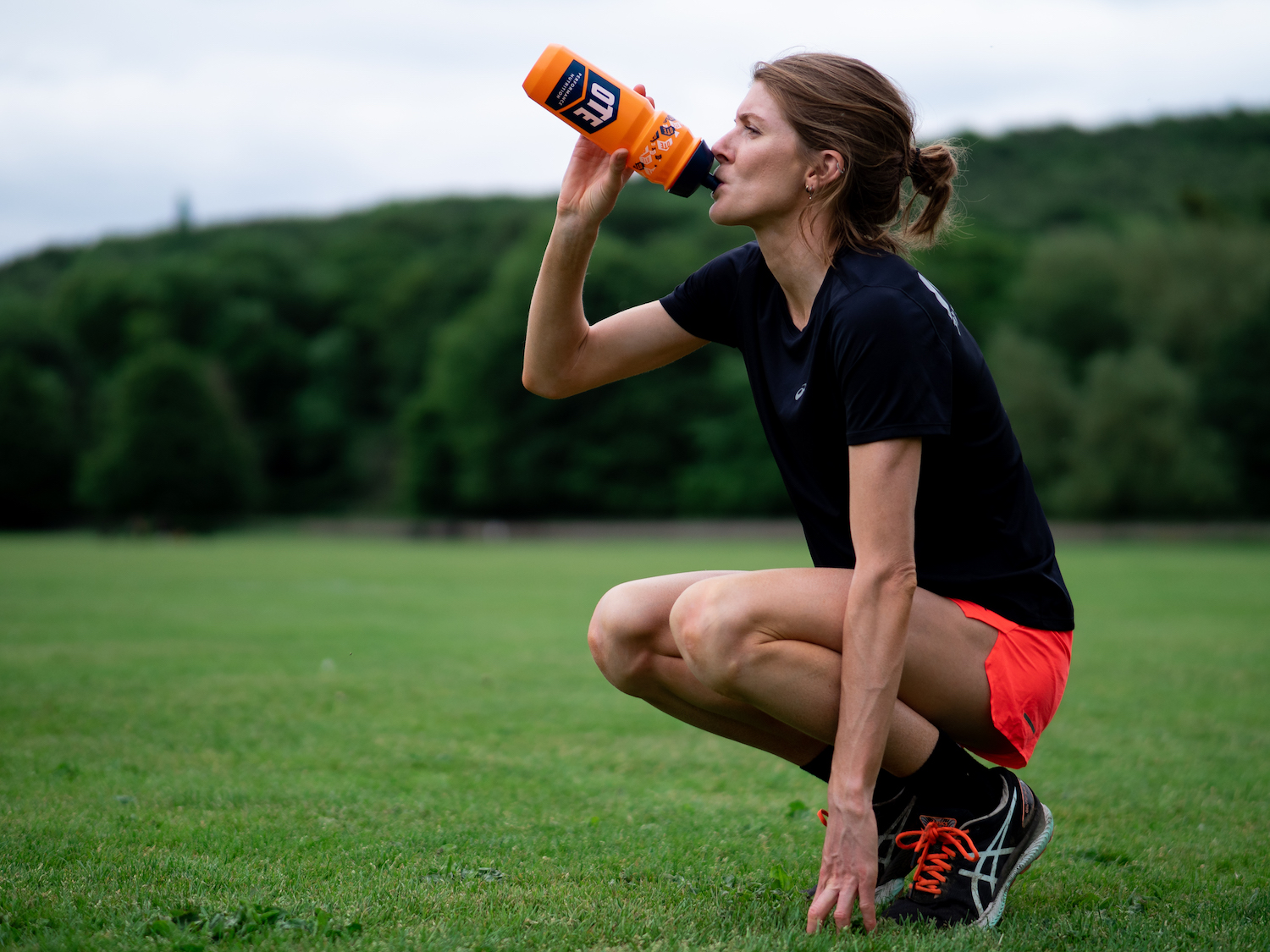

Featured
How To Prepare For 10K Run
Modified: August 21, 2023
"Discover the best tips and strategies to prepare for a featured 10K run in this comprehensive guide. Get ready to conquer the distance and achieve your running goals!"
Introduction
Preparing for a 10K run requires dedication, discipline, and a well-structured training plan. Whether you are a seasoned runner looking to improve your performance or a beginner embarking on your first race, this article will guide you through the essential steps to get ready for the challenge.
A 10K run, which covers a distance of 10 kilometers or 6.2 miles, is a popular choice for runners of all levels. It offers a balanced combination of endurance and speed, making it a great goal for both recreational and competitive runners. By following the tips and strategies outlined in this article, you will not only improve your physical fitness but also boost your confidence and enjoy the overall experience of the race.
Before lacing up your running shoes, it’s important to set clear and realistic goals for yourself. Ask yourself what you hope to achieve by completing the 10K run. Are you aiming for a specific time? Or perhaps you want to challenge yourself and complete the race without walking. Setting these goals will give you a sense of purpose and motivation throughout your training journey.
Once you have established your goals, the next step is to create a well-rounded training plan. This plan should include a mix of running workouts, cross-training, and rest days to ensure you build endurance while also allowing your body time to recover and prevent injuries. Gradually increasing your mileage and intensity over time is key to avoiding burnout and improving your overall performance.
In addition to running, incorporating other forms of exercise such as strength training and flexibility exercises will help enhance your overall fitness and reduce the risk of injury. Proper nutrition and hydration are also crucial components of your training journey, as they provide the fuel your body needs to perform at its best. Finally, mental preparation and motivation play a significant role in achieving your desired results on race day.
In the following sections, we will delve into each of these aspects in detail, providing you with practical tips and strategies to help you prepare for your 10K run effectively. By the end of this article, you will have the tools and knowledge needed to embark on your training journey with confidence and set yourself up for a successful and enjoyable race day.
Setting Your Goal
Setting a clear and specific goal is paramount when preparing for a 10K run. Your goal will serve as a guiding light throughout your training journey and keep you motivated when faced with challenges along the way.
Start by assessing your current fitness level and running experience. If you are a beginner or have never run a 10K before, it may be more realistic to focus on completing the race without walking rather than aiming for a specific time. As your fitness improves, you can gradually set time goals for future races.
When setting your goal, make sure it is achievable and realistic. Consider factors such as your current running ability, available training time, and any potential limitations or injuries you may have. Setting a goal that is too aggressive can lead to burnout or injury, so be honest with yourself about what is attainable given your current circumstances.
In addition to a specific time or completion goal, consider setting process-oriented goals as well. These are goals related to your training routine and habits, such as committing to a certain number of training days per week, incorporating strength training, or improving your mileage gradually. Focusing on these smaller, actionable goals will help you stay consistent and motivated throughout your training program.
Lastly, it can be helpful to share your goals with others. By vocalizing your intentions, you hold yourself accountable and create a support system that can motivate and encourage you along the way. Share your goals with friends, family, or join a local running group where you can find like-minded individuals who share your passion for running.
Remember, goals are personal, and what matters most is that they resonate with you. They should challenge and inspire you to push your boundaries but also be within reach. Setting a goal that excites you and aligns with your current abilities will spark your motivation and drive your determination as you prepare for your 10K run.
Creating a Training Plan
An effective training plan is essential for preparing for a 10K run. It provides structure, ensures gradual progression, and helps prevent overtraining or injury. Here are some key steps to create a training plan that suits your needs:
1. Determine the duration: Consider how many weeks you have until race day. Typically, a 10K training plan ranges from 8 to 12 weeks, depending on your current fitness level and goals.
2. Establish a baseline: Assess your current running abilities by measuring your comfortable running distance and pace. This will help you determine where to start in your training and pace yourself accordingly.
3. Set a mileage and frequency target: Decide how many miles you want to run each week and how many days you can commit to running. It is recommended to have at least three to four running days per week to build endurance and consistency.
4. Gradually increase mileage: Plan to increase your weekly mileage by no more than 10% each week. This progressive overload allows your body to adapt to the increasing demands of running and minimizes the risk of overuse injuries.
5. Incorporate cross-training and rest days: Include cross-training activities such as cycling, swimming, or strength training on select days to improve overall fitness and prevent boredom. Rest days are just as important as running days, as they allow your body to recover and rebuild, reducing the risk of injury.
6. Vary your workouts: Include different types of runs in your training plan to improve endurance and speed. Incorporate long runs for building endurance, tempo runs for increasing speed, and interval or hill workouts for improving stamina and strength.
7. Listen to your body: Pay attention to any discomfort or signs of overtraining. Modify or reduce the intensity or frequency of your training if necessary to prevent injury. It’s better to take a rest day or seek medical advice rather than push through pain and risk long-term setbacks.
8. Adapt and adjust: Be flexible with your training plan, especially if unexpected circumstances or obstacles arise. Life happens, and it’s important to adapt and adjust your plan accordingly while staying focused on your ultimate goal.
Remember, a training plan is not set in stone. It should be tailored to your individual needs and account for your current fitness level and schedule. Be consistent, patient, and trust the process as you gradually build your endurance and prepare for your 10K run.
Building Endurance
Building endurance is a crucial aspect of preparing for a 10K run. It allows you to sustain a steady pace and complete the race without feeling exhausted. Here are some key strategies to help you increase your endurance:
1. Long runs: Incorporate one long run per week into your training plan. Start with a distance that is comfortable for you and gradually increase it over time. This will help build your aerobic capacity, improve running economy, and mentally prepare you for the demands of race day.
2. Slow and steady: Focus on maintaining a conversational pace during your long runs and easy runs. This means running at a pace at which you can comfortably hold a conversation. Running too fast during training can lead to burnout and hinder your endurance development.
3. Tempo runs: Tempo runs are slightly faster than your easy pace and aim to improve your lactate threshold. During a tempo run, aim to maintain a comfortably hard pace for a sustained period, such as 20-30 minutes. This will help improve your body’s ability to clear lactate and sustain a faster pace for longer periods.
4. Fartlek training: Fartlek, which means “speed play” in Swedish, involves alternating between periods of faster running and slower recovery jogging. This type of training can improve your cardiovascular fitness, enhance your endurance, and add some variety to your workouts.
5. Interval training: Interval training involves alternating between high-intensity bursts of speed and recovery periods. These intense intervals can help improve both your running efficiency and aerobic capacity. Start with shorter intervals, such as 400 meters, and gradually increase the duration as your fitness improves.
6. Cross-training: Incorporate activities such as cycling, swimming, or elliptical training into your routine. These low-impact exercises can help build endurance without putting excessive strain on your joints. They also provide variety and give your muscles a break from running while still improving overall fitness.
7. Consistency is key: Stay consistent with your training and gradually increase your mileage and intensity. Aim to have a balanced approach, ensuring you have rest days and easier runs mixed in with your harder workouts. This will allow your body to adapt and recover, reducing the risk of overuse injuries.
Remember, building endurance takes time and patience. It is a gradual process, so be persistent and trust in your training program. As you continue to work on your endurance, you will notice improvements in your ability to maintain a steady pace and conquer the 10K distance with confidence.
Developing Speed and Stamina
Developing speed and stamina are essential for improving your performance and achieving your goals in a 10K run. By incorporating specific workouts and training techniques into your routine, you can build the necessary speed and endurance to push your boundaries. Here are some strategies to help you develop your speed and stamina:
1. Interval training: Intervals involve alternating between high-intensity bursts of speed and recovery periods. This type of training helps improve your anaerobic capacity and increases your ability to sustain a faster pace. Start with shorter intervals, such as 200 or 400 meters, and gradually increase the length or intensity as your fitness improves.
2. Hill repeats: Hills are an excellent tool for building strength, speed, and mental toughness. Incorporate hill repeats into your training by finding a hill with a moderate gradient. Run up the hill at a fast pace, focusing on using your arms and maintaining proper form, and jog or walk back down for recovery. Repeat the process several times to build leg power and improve cardiovascular fitness.
3. Tempo runs: Tempo runs involve running at a comfortably hard pace, just below your maximum effort. This pace should be sustainable for a longer duration, such as 20-30 minutes. Tempo runs help improve your lactate threshold, allowing you to maintain a faster pace for a longer period without accumulating fatigue.
4. Fartlek training: Fartlek, which means “speed play” in Swedish, involves incorporating short bursts of speed into your regular runs. During your run, pick a landmark such as a tree, lamppost, or street corner, and sprint to that point. Then return to your normal pace. These random bursts of speed challenge your body and improve your ability to accelerate when needed during a race.
5. Plyometric exercises: Incorporating plyometric exercises into your training routine can enhance your power and speed. Jumping exercises like box jumps, squat jumps, and jump lunges help develop explosive strength in your lower body, which translates to faster running. It’s important to perform these exercises with proper form and gradually increase the intensity as your strength improves.
6. Strides: Strides are short, fast bursts of running, typically around 100 meters. Incorporate strides into your runs to improve your running form, stride efficiency, and turnover rate. Gradually accelerate to a fast pace, hold it for a few seconds, and then decelerate. Repeat the process several times, focusing on maintaining good running technique.
7. Cross-training: Engaging in cross-training activities like cycling, swimming, or rowing can improve your cardiovascular fitness without the repetitive impact of running. These activities can enhance your stamina and aerobic capacity, helping you become a more well-rounded and resilient runner.
Remember, developing speed and stamina takes time and consistent effort. Incorporate these training techniques into your routine gradually and listen to your body. Balance your hard workouts with adequate rest and recovery to avoid overtraining and reduce the risk of injury. By consistently working on speed and stamina, you will become a stronger and faster runner, ready to conquer the 10K distance.
Incorporating Strength Training
Strength training is a valuable component of a well-rounded training program for a 10K run. It not only helps prevent injuries but also improves running efficiency, power, and overall performance. Here are some key reasons why you should incorporate strength training into your routine and how to do it effectively:
1. Injury prevention: Strength training helps strengthen muscles, tendons, ligaments, and bones, reducing the risk of common running injuries such as shin splints, IT band syndrome, and stress fractures. It also improves stability and balance, which are crucial for maintaining proper running form.
2. Running economy: Strength training improves your running economy, which is the efficiency at which you utilize oxygen while running. By strengthening your muscles and improving their power output, you become more efficient and expend less energy to maintain your pace.
3. Power and speed: Strength training enhances your overall power and speed, allowing you to generate more force with each stride. This translates to faster race times and improved performance in the 10K run. Strong muscles also help maintain proper running posture and increase your ability to push through fatigue.
4. Core strength: A strong core is essential for maintaining stability and proper running form. Incorporate exercises that target your core, such as planks, Russian twists, and bicycle crunches, into your strength training routine. A stable core improves your running efficiency and reduces the risk of injuries caused by compensatory movements.
5. Lower body strength: Focus on exercises that strengthen your lower body, including squats, lunges, deadlifts, and calf raises. These exercises target the major muscle groups used in running, such as the quadriceps, hamstrings, glutes, and calves. Building strength in these areas will improve your power, endurance, and overall running performance.
6. Balance and flexibility: Incorporate exercises that improve balance and flexibility, such as single-leg squats, yoga, and dynamic stretching. Good balance helps prevent falls and improves stability on uneven terrain. Flexibility exercises enhance your range of motion and stride length, optimizing your running mechanics.
7. Periodization: Incorporate strength training into your training plan by alternating between different phases of training. Focus on building strength and muscle during the off-season and early phases of training. As race day approaches, shift to maintenance strength workouts that complement your running schedule.
8. Recovery and rest: Allow for rest days between strength training sessions to avoid overtraining and promote muscle recovery. Strength training breaks down muscle fibers, and rest is crucial for them to rebuild and become stronger. Adequate rest also helps prevent fatigue and promotes overall recovery.
Remember to consult with a qualified fitness professional if you’re new to strength training or if you have any underlying health concerns. They can help create a personalized strength training program that complements your running goals and ensures proper form and technique.
By incorporating strength training into your routine, you will not only prevent injuries but also improve your running efficiency, power, and overall performance. Be consistent, listen to your body, and embrace the benefits of strength training as you prepare for your 10K run.
Proper Nutrition for Training
Proper nutrition plays a vital role in fueling your body and optimizing performance during your 10K training. It provides the energy, nutrients, and hydration needed to support your workouts, aid in recovery, and enhance your overall running performance. Here are some key guidelines to help you maintain a well-balanced and nourishing diet:
1. Fueling for workouts: Prioritize consuming a balanced meal or snack containing carbohydrates, protein, and healthy fats before your training sessions. Carbohydrates are the main source of energy, while protein helps with muscle repair and growth. Opt for easily digestible options such as a banana with peanut butter or a small bowl of oatmeal with berries.
2. Hydration: Staying hydrated is crucial for optimal performance. Aim to drink enough water throughout the day, as well as before, during, and after your runs. Monitor your urine color to ensure it is pale yellow, indicating proper hydration. Consider using electrolyte-rich beverages or sports drinks for longer or more intense workouts to replenish electrolytes lost through sweat.
3. Post-workout nutrition: Refuel your body with a combination of carbohydrates and protein within 30 minutes of completing your training session. This helps replenish glycogen stores, repair muscle damage, and facilitate recovery. A well-balanced post-workout snack could include a protein shake, Greek yogurt with fruit, or a turkey and avocado sandwich on whole-grain bread.
4. Macronutrients: Ensure you are getting an adequate intake of carbohydrates, proteins, and fats. Carbohydrates provide the primary source of energy for endurance exercise, while proteins help with muscle repair and recovery. Include complex carbohydrates like whole grains, lean sources of protein such as chicken or beans, and healthy fats from sources like avocados or nuts in your meals.
5. Micronutrients: Don’t overlook the importance of micronutrients in your diet. Vitamins and minerals play a key role in maintaining overall health and supporting optimal performance. Include a variety of fruits, vegetables, and whole foods in your meals to ensure you’re getting a wide range of nutrients.
6. Meal timing: Spread your meals and snacks throughout the day to provide a steady source of energy. Aim for three balanced meals and two to three small, nutritious snacks to keep your energy levels stable and support your training needs.
7. Listen to your body: Each individual is different, so pay attention to how your body responds to different foods and adjust your diet accordingly. Experiment with different meal timing strategies and food choices to find what works best for you. Consult with a registered dietitian if you need personalized recommendations based on your specific goals and requirements.
8. Consistency: Develop good eating habits by making nutrition a consistent part of your training routine. Plan and prepare your meals in advance to ensure you have wholesome and nutrient-dense options readily available.
Remember, proper nutrition is not only important during your training but also throughout your daily life. Focus on nourishing your body with whole, unprocessed foods and hydrating adequately to support your overall health and running performance.
Hydration and Fueling Strategies
Hydration and fueling strategies are crucial for optimal performance during your 10K training. Proper hydration ensures that your body functions optimally, while fueling with the right nutrients provides the energy needed for your workouts. Here are some strategies to help you stay hydrated and properly fueled:
1. Hydration during workouts: Hydrate before, during, and after your training sessions. Start your run well-hydrated by drinking water in the hours leading up to your workout. During longer runs or intense workouts, aim to drink 4-8 ounces of water or a sports drink every 15-20 minutes to maintain hydration levels. Experiment with different hydration strategies during training to find what works best for you.
2. Electrolyte replenishment: Electrolytes, such as sodium, potassium, and magnesium, are essential minerals that regulate fluid balance and help prevent muscle cramps. Consider using electrolyte-rich beverages, such as sports drinks or electrolyte tablets, during longer or more intense workouts to replace what is lost through sweat and promote hydration.
3. Post-workout hydration: After completing a training session, prioritize rehydration by consuming fluids and electrolyte-rich beverages. Aim to drink at least 16-24 ounces of fluid for every pound lost during exercise. Monitor your urine color to ensure it is pale yellow, indicating proper hydration.
4. Pre-workout fueling: Consume a balanced meal or snack that includes carbohydrates and a small amount of protein before your training sessions. This will provide you with the necessary energy to perform at your best. Choose easily digestible options such as a banana, toast with nut butter, or a sports energy bar.
5. During-run fueling: For runs lasting longer than 60-90 minutes, consider fueling with carbohydrates to maintain your energy levels. Options include energy gels, chews, or sports drinks that provide easily digestible carbohydrates. Experiment with different fueling products during your training to find the ones that work best for you and don’t cause gastrointestinal distress.
6. Recovery nutrition: Proper post-workout nutrition is crucial for replenishing glycogen stores, repairing muscles, and promoting recovery. Consume a snack or meal within 30 minutes of finishing your run that includes a combination of carbohydrates and protein. Good options include a protein shake, a smoothie with fruit and Greek yogurt, or a balanced meal with lean protein and whole grains.
7. Individualize your fueling and hydration plan: Every runner is unique, so it’s important to experiment with different strategies and listen to your body. Pay attention to how you feel during your runs and adjust your fueling and hydration plan accordingly. Consider working with a sports nutritionist to develop a personalized plan based on your specific needs and goals.
8. Stay consistent: Hydration and fueling should not only be practiced during your training but also become a consistent part of your daily habits. Make sure to prioritize hydration and consume nutrient-rich foods in your daily diet to support your overall health and performance.
Remember, proper hydration and fueling are essential for maintaining performance, preventing dehydration, and avoiding the dreaded “hitting the wall” during your 10K run. Develop a strategy that works best for you and make it a priority throughout your training and on race day.
Injury Prevention and Recovery
Ensuring proper injury prevention and recovery strategies are integral to a successful 10K training program. By taking proactive steps to prevent injuries and implementing effective recovery techniques, you can keep your body healthy and reduce the risk of setbacks. Here are some key strategies to help you stay injury-free and promote recovery:
1. Warm-up and cool-down: Prior to each run, perform a dynamic warm-up routine to prepare your muscles and joints for the upcoming workout. This may include exercises such as leg swings, lunges, and light jogging. After your run, engage in a cool-down routine that incorporates gentle stretches to promote flexibility and relaxation.
2. Gradual progression: Avoid the temptation to increase your mileage or intensity too quickly. Gradually build up both your distance and intensity to allow your body time to adapt and strengthen. A safe guideline is to increase your total weekly mileage by no more than 10% per week.
3. Listen to your body: Pay attention to any warning signs of potential injuries, such as persistent pain or discomfort. Address these issues promptly by easing back on training, seeking professional guidance, or incorporating cross-training and rest days into your routine. Ignoring pain can lead to more significant injuries and longer recovery periods.
4. Strength and flexibility training: Incorporate strength training exercises that target the key muscles used in running, such as the hips, glutes, and core. Strengthening these areas helps improve running mechanics and reduces the risk of overuse injuries. Additionally, regular stretching and flexibility exercises can improve your range of motion and prevent muscle imbalances.
5. Cross-training: Engaging in other low-impact activities such as cycling, swimming, or yoga can provide a break from the repetitive stress of running while still maintaining your cardiovascular fitness. Cross-training helps strengthen different muscle groups, improves overall fitness, and reduces the risk of overuse injuries.
6. Rest and recovery: Ensuring proper rest and recovery is crucial for allowing your body to repair and rebuild after intense training. Incorporate rest days into your training schedule and prioritize quality sleep. Adequate sleep promotes muscle recovery, hormonal balance, and overall well-being.
7. Nutrition: Proper nutrition plays a vital role in injury prevention and recovery. Ensure you are consuming a well-balanced diet that includes a variety of whole foods to provide your body with the necessary nutrients for repair and optimal functioning. Include foods rich in antioxidants, omega-3 fatty acids, and lean proteins to aid in healing and reduce inflammation.
8. Professional guidance: Seek help from a qualified professional, such as a physical therapist or sports medicine specialist, if you experience persistent pain or injuries. They can assess your running mechanics, provide personalized recommendations, and design a specific plan to address any issues or imbalances.
Remember, preventing injuries and promoting recovery are essential elements of a successful 10K training program. By incorporating these strategies into your routine, you can keep your body strong, minimize the risk of injuries, and ensure you are in optimal condition for race day.
Mental Preparation and Motivation
Mental preparation and motivation are key factors in achieving success in a 10K run. Running long distances can be physically challenging, but it is equally important to develop mental strength and a positive mindset. Here are some strategies to help you enhance your mental preparation and stay motivated throughout your training:
1. Set clear goals: Define your goals for the 10K run and make them specific, measurable, attainable, relevant, and time-bound (SMART). Write them down and keep them visible as a constant reminder of what you are working towards. Having clear goals gives you a sense of purpose and direction.
2. Visualization techniques: Use visualization to mentally rehearse your race day. Imagine yourself crossing the finish line, feeling strong and accomplished. Visualizing success can boost your confidence and help you overcome any doubts or anxieties you may have.
3. Positive self-talk: Replace negative thoughts with positive affirmations and self-talk. Remind yourself of your capabilities and inner strength. Repeat affirmations such as “I am strong,” “I can do this,” or “I am prepared.” Cultivating a positive mindset can help you stay motivated and focused when training gets tough.
4. Break it down: Instead of focusing on the entire 10K distance, break it down into smaller, manageable intervals or milestones. Celebrate each milestone as you progress during your training. This approach helps you stay present and motivated, rather than feeling overwhelmed by the overall distance.
5. Find a training partner or join a running group: Having a training partner or being part of a running group can provide support, motivation, and accountability. The camaraderie and shared experiences can help you stay motivated, especially on days when you may feel less inspired to train.
6. Create a motivating playlist: Compile a playlist of energizing and inspiring songs that uplift your mood and keep you motivated during your runs. Music can provide a significant boost in motivation, distract you from fatigue, and even help you maintain a steady pace.
7. Mix up your training routines: Avoid monotony by varying your training routes, types of runs, and workouts. Incorporate different training techniques, such as intervals, tempo runs, or fartlek training, to keep your training enjoyable and challenging. The variety keeps your mind engaged and helps prevent boredom.
8. Celebrate milestones and small wins: Acknowledge and celebrate your achievements along the way, whether it’s completing a challenging workout, reaching a new distance milestone, or seeing improvements in your pace. Recognizing your progress and giving yourself credit for your efforts keeps your motivation high and boosts your confidence.
Remember, mental preparation is just as important as physical training when it comes to a 10K run. Cultivating a positive mindset, staying motivated, and developing mental resilience will help you stay focused, overcome challenges, and perform your best on race day.
Race Day Tips and Strategies
Race day is the culmination of your training, and proper preparation is essential to ensure a successful and enjoyable 10K run. Here are some tips and strategies to help you make the most of your race day experience:
1. Stick to your routine: Stick to your tried and tested routine on race day. Avoid trying anything new with regards to clothing, shoes, or diet. Stick to the gear and nutrition that you have utilized in your training, ensuring maximum comfort and minimal surprises.
2. Get a good night’s sleep: Prioritize getting a restful night’s sleep before race day. Aim for 7-8 hours to ensure you wake up feeling refreshed and energized. Avoid any late-night activities or screen time that could disrupt your sleep patterns.
3. Plan your meals: Plan your pre-race meals carefully. Have a light and easily digestible meal 2-3 hours before the race start time, consisting of carbohydrates for fuel and a small amount of protein. Avoid heavy or unfamiliar foods that could potentially cause stomach discomfort during the race.
4. Arrive early and warm up: Give yourself ample time on race day to arrive, collect your race packet, and familiarize yourself with the start area. Plan to arrive at least an hour before the race begins. Use this time to warm up with some light jogging, dynamic stretches, and strides to prepare your muscles for the race ahead.
5. Pace yourself: Start the race at a comfortable pace that you have familiarized yourself with during your training. Avoid the temptation to go out too fast at the beginning, as this can lead to fatigue later on. Trust your training and settle into a sustainable pace that allows for a strong finish.
6. Stay hydrated: Hydrate adequately before and during the race. Take advantage of water stations along the course, and consider carrying a small water bottle or hydration pack if necessary. Sip small amounts of water or sports drink at regular intervals to maintain hydration levels and avoid overconsumption that could lead to discomfort.
7. Break down the distance: Mentally break down the race distance into manageable sections or landmarks. Focus on reaching each milestone rather than fixating on the entire distance. Set smaller goals, such as reaching the next kilometer marker or passing a certain landmark, to keep yourself motivated and engaged.
8. Stay positive and focused: Maintain a positive mindset and stay mentally focused throughout the race. If negative thoughts or doubts creep in, counter them with positive self-talk and affirmations. Visualize yourself crossing the finish line strong and embrace the energy and support from fellow runners and spectators.
9. Take in the experience: Embrace the atmosphere of the race and enjoy the experience. Smile, acknowledge the cheers from the crowd, and appreciate the journey you have taken to reach this point. Remember that the 10K run is not just about the finish line, but also about the personal growth and fulfillment that comes with it.
10. Finish strong: As you approach the final stretch of the race, summon up your energy and give it your all. Maintain good form, focus on your breathing, and accelerate towards the finish line. Dig deep and draw upon the mental and physical strength you have built throughout your training to finish the race strong.
Remember, race day is the culmination of weeks or months of training and preparation. Trust in your training, stay positive, and enjoy the experience. Embrace the challenge, celebrate your achievement, and revel in the sense of accomplishment when you cross that finish line.
Conclusion
Preparing for a 10K run requires commitment, discipline, and a well-rounded approach. Throughout this article, we have explored various aspects of training, from setting clear goals and creating a structured training plan to building endurance, developing speed and stamina, incorporating strength training, and ensuring proper nutrition, hydration, and recovery.
In addition to the physical aspects of training, we emphasized the importance of mental preparation and motivation. Cultivating a positive mindset, visualizing success, and staying focused are key factors that can make a significant difference in your performance on race day.
Remember, each runner is unique, and it is essential to tailor your training and strategies to your specific needs, abilities, and goals. Listen to your body, make adjustments when necessary, and seek professional guidance if needed.
Above all, enjoy the journey. Embrace the challenges, the highs, and the lows. Cherish the small victories and milestones that you achieve along the way. The 10K run is not just a race; it’s an opportunity for personal growth, self-discovery, and a celebration of your dedication and determination.
As you lace up your running shoes and embark on your 10K training, remember to stay committed, stay consistent, and believe in yourself. Trust in the process, and know that the hard work you put in during training will pay off on race day.
So, tie your shoelaces, set your goals, and let the training begin. Embrace the challenges, celebrate the victories, and enjoy the experience of pushing your limits and accomplishing what once seemed impossible. Whether it’s your first 10K or your tenth, may it be a race filled with personal growth, joy, and the satisfaction of crossing the finish line with a smile on your face.









